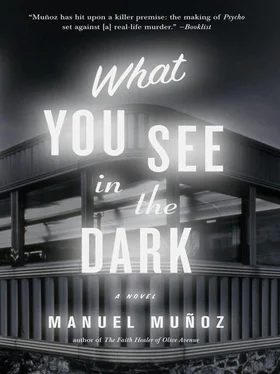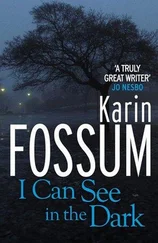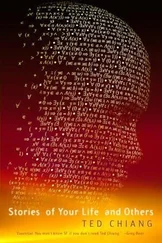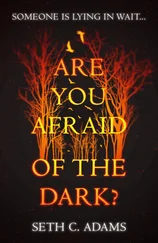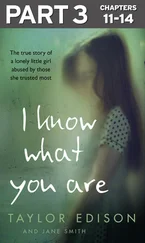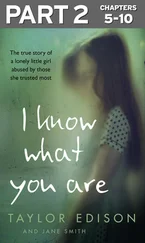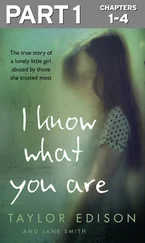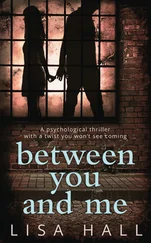Manuel Munoz
What You See in the Dark
If the thirst for love
is not the thirst for death, what is it?—
— Ai, “Last Seen”
If you had been across the street, pretending to investigate the local summer roses outside Holliday’s Flower Shop, you could have seen them through the café’s plate glass, the two sitting in a booth by the window, eating lunch. You could have seen them even if you had been inside the shop, peering from behind the window display of native Bakersfield succulents, wide-faced California sunflowers, blue flax in hanging pots. The two of them sat in full view of everyone passing by, minding their own business. Their mouths moved alternately in long, drawn-out soliloquies, or sometimes they paused and deliberated, as if they had to choose their words carefully, grinning if they spoke at the same time. The girl was eating a thin sandwich and taking short sips from a thick glass of cola. The man ate with a knife and fork, his elbows up in a sawing motion, his eyes sometimes looking down to concentrate.
He was the most handsome man in town for sure, and his mother owned a little motel out on the highway. He always seemed to be wearing only brand-new shirts: no one could keep shirts that color, that softness, time after time, hanging them to dry stiff on a backyard line.
He would be a good man to marry.
They were eating in the café located on one of the choice corners on a better stretch of Union Avenue, the café that still had the plate-glass windows all the way down to the sidewalk, one of the few places that still did after the’52 earthquake. You could see the entire booth through those windows: the table, the red vinyl, their dishes, the waitress’s white shoes when she came by to check on them, how the girl crossed her feet and rocked them nervously. She was not dressed as crisply as he was. Even if her clothes looked clean and pressed, you could tell right off that the day she began wearing nice things around town was the day the two of them had done more than talk and have lunch. His mother, whom everybody knew, had worked at the café since before the earthquake, and the waitresses who served him at any of the shifts — breakfast, lunch, dinner, or late-night coffee and cherry pie — had all known him as a boy, so it was hard to tell if their attentions to him were motherly or something more flirtatious.
And yet the one to grab his attention was that skinny brown girl who lived above the bowling alley. Always on foot, always staring into the windows of the record shop, of the TG&Y, of the furniture store, of the Rexall, even of the shoe store where you worked, as if she hadn’t set up the displays herself. A very plain girl, not too tall, with slender hips, and hair as dark as her mother’s. Her mother had worked at the café, too — with his mother, in fact — almost eight or nine years ago. No doubt his mother remembered.
You could see that girl walking to work at the shoe store, back and forth, going to her apartment during the lunch hour, then home again by the end of the day, no matter what the Valley weather brought: summer heat, fall rains, the terrible winter fog. Even in late November and December, when the sun had gone down by near five o’clock and the streets fell dark, she would walk home alone after the store closed. And that’s how it should have stayed, a plain girl like that all alone.
But now this: a thin sandwich and Dan Watson, who was surely going to pay for it, then the waitress coming round with the dessert menu, the girl glancing at the clock, Dan urging her to choose something, then clearly instructing the waitress to hurry back. The waitress indulges him, of course, he being who he is, and comes back with two small silver dishes of vanilla ice cream. He leans over and spoons a small scoop of her ice cream into the cola glass. There is still a lot of soda left, the way she has been sipping it, savoring it. He points for her to take a taste and she does so warily, as if she’s never tasted anything like it before. But you have to believe she never has, once that look crosses her face, an amused arch of her eyebrows and a nod of approval.
How people change when they get a taste of the good life! When suddenly the dollar bills in your hand can go for things you want instead of need. A fork-and-knife meal at the café; scarves and pearl chokers; pendants and brooches; jewelry boxes with ballerinas springing to attention; that lovely sound of pushing rings and earrings and bracelets against each other while you’re searching. Flowers from Holliday’s like the good husbands do: tulips and Easter lilies from Los Angeles in the springtime, a wrist corsage for attending a wedding. A car trip over to the coast, to Morro Bay and the enormous, beautiful rock basking just off the shoreline. A day in Hollywood, the exhilaration of knowing movie stars breathe in the very same sunshine. Silk blouses brought home in delicate paper; dresses that require dry cleaning; lingerie so elegant it refuses to be scandalous.
Is that the life she knows she has ahead of her, the way she is sitting there, her feet rocking nervously after nearly a whole hour? Does she know how every young woman in town wants exactly this? Does she know that people turn their heads to watch them leave the café, to watch him open the door of his Ford truck for her? Does she know people discuss what they’ve seen, what his mother must think?
Summer carries on, the heat still scorching into September. Harvest time has arrived in Bakersfield and more people have come into town looking for work, whole caravans sometimes. Faces are not as familiar as before, not at the supermarkets, not on the downtown streets. Bakersfield is the open door to the southern part of the state, and the workers come pouring through. So many people have arrived that it becomes difficult to find parking spots, to buy fresh meat, even to get a bench at the Jolly Kone hamburger stand. But this will be short lived — by the end of October, after much of the late-summer crop has been brought in from the fields, the town will go back to normal. The strangers will leave, counting their money, and Bakersfield will wait for those first few weeks of November when the sky goes gray and the fog rolls in over the coastal range and lingers for months on end.
In all the commotion of the harvest boom, most people don’t notice that the girl is no longer walking the streets to work. At the lunch hour, she’s nowhere to be seen over near Chester Avenue, where her apartment is. But at the shoe store, she’s there sure enough, dutifully stepping from the back storage room when Mr. Carson snaps his fingers and tells her the sizes he needs. She never says a word unless a Spanish-speaking customer comes in: this is why she was hired. Mr. Carson cannot refuse the potential business from these customers and leaves the girl to tend to them, stepping away and occupying himself with other business. The girl points to several shoes — she never used to do that! — and smiles boldly at the Spanish-speaking customers, bringing out boxes and boxes for inspection.
Enough word has gotten around town about her eye for beautiful shoes, for high heels that don’t necessarily strain the arches, for knowing a budget without having to ask. She moves with confidence and assurance, even if she is not allowed to ring up the sales on her own. She stands nearby to translate, and you handle the money: you, the girl who should be trusted, the kind of girl that should end up with a man like the one she has.
She is no longer walking the streets, but riding around with Dan Watson, her elbow resting on the truck door while they drive with the windows rolled down. The two of them at the café for lunch sometimes, the waitresses acting as if nothing could be less ordinary. The two of them stepping out of the record shop several times a week with brown-papered packages stuck under his arms. People saying, by late September, that she’s picked up a second job, serving drinks to the patrons over at Las Cuatro Copas, the place where her boyfriend tends bar, and the owner of the rival place across the street is peeved because even the white crowd has trickled over there just to get a look at her.
Читать дальше
